Electrical advice
How to change a plug socket
26 Mar 2021 • 13 minutes
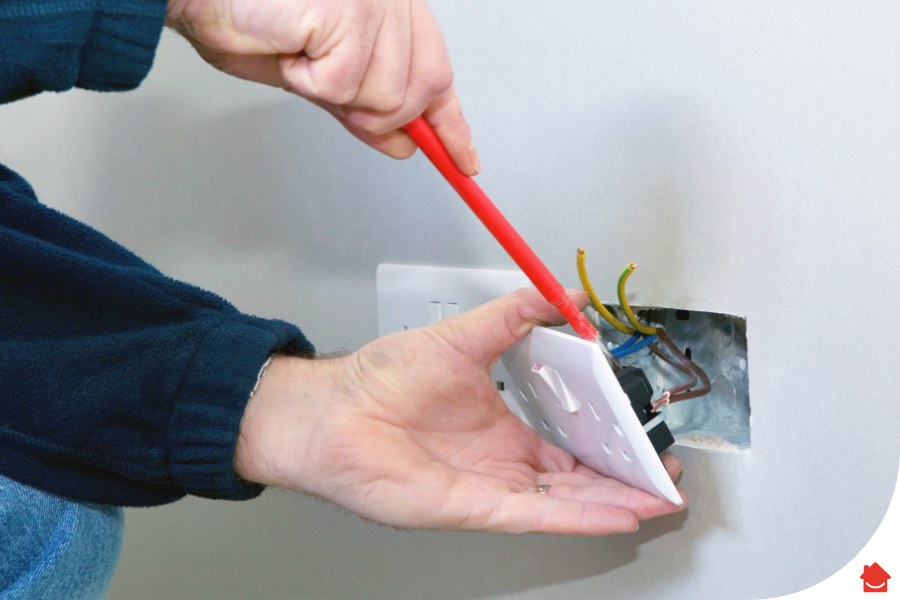

Replacing your old plug sockets with new ones is a quick and easy way to modernise your house and add new functions like USB sockets. Alternatively, you may need to replace a damaged or scorched socket.
The question is, where do you start?
Read on to find out what equipment you’ll need to replace your electrical sockets safely, and how to replace each socket with minimum fuss.
It’s important to remember that any electrical work should be carried out by a skilled electrician, who has the right level of training and experience. By ensuring that the right risk assessments are carried out hazards can be avoided and work can be completed as safely as possible.
First, you need to plan and prepare. What kind of replacement plug sockets do you want and what kind of equipment will you need? What kind of safety precautions should you take? Let’s dive in.
These days, electrical sockets can be surface or flush-mounted.
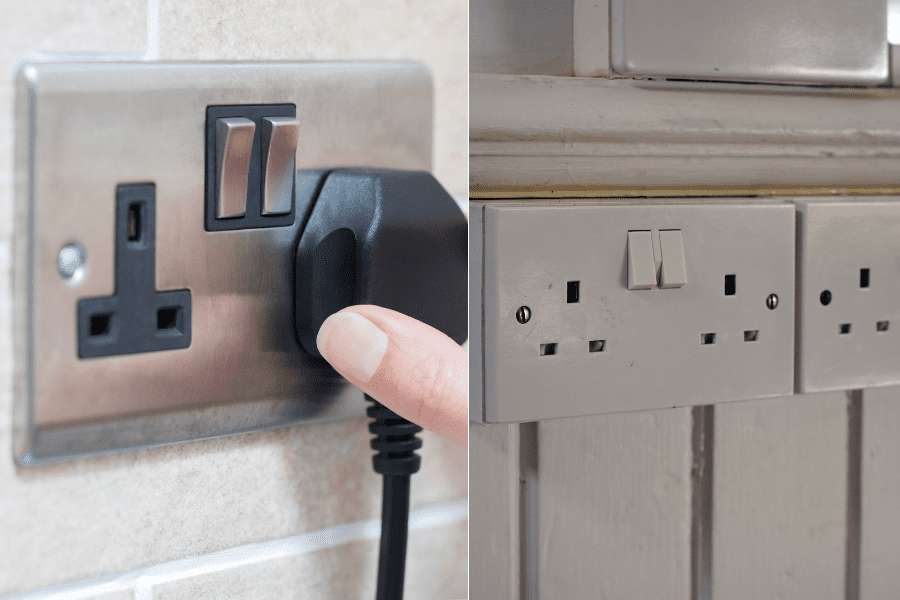 The traditional surface-mounted white box sockets are definitely easier to fit – you screw the box to the wall, with the cable run in and the faceplate attached. However, flush-mounted sockets look more modern and are less prone to accidental damage because they don’t stick out of the wall so much.
The traditional surface-mounted white box sockets are definitely easier to fit – you screw the box to the wall, with the cable run in and the faceplate attached. However, flush-mounted sockets look more modern and are less prone to accidental damage because they don’t stick out of the wall so much.
Flush-mounted sockets are available in a range of sizes, colours and finishes, with some more modern designs also featuring USB ports and Wi-Fi extenders.
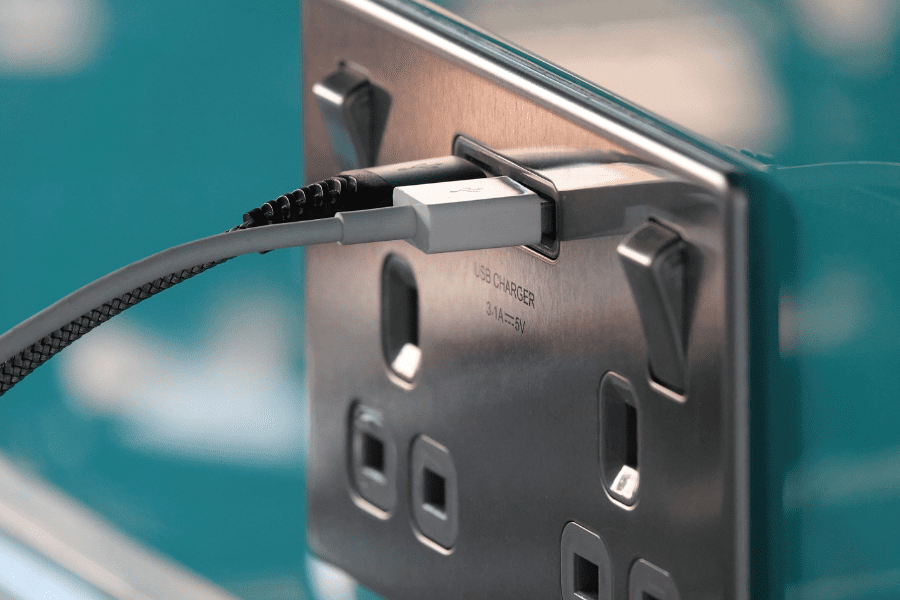
Do you often find yourself searching the house for a USB adaptor plug? Or maybe you have to unplug other chargers or your bedside lamp to charge your phone at night… You may even have charger wars going on with your partner or children! If this is you, a USB plug socket or two could be a game-changer in your household.
USB sockets are easy to fit and are great replacements for your existing double sockets, as all you have to do is fit it. They’re exactly the same size and can be bought from most DIY and electrical shops
USB sockets are just as safe as any other electrical socket. You must never take risks with electrical safety, always purchase a reputable brand and ensure it has a BSI Kitemark and CE logo.
If you have any doubts or queries or don’t know what to do after checking the packaging, then it’s best to contact a professional electrician who is registered with an electrical certification scheme. Don’t gamble with electrical safety.
Please also bear in mind that electrical installations and alterations are subject to local building and electrical regulations that you must comply with. You can check the regulations in your area at Electrical Safety First or on your Local Authority website.
The steps to fit the different types of sockets (including USB sockets) are as follows.
Never attempt to do work on your electrics unless you know for sure that the circuit is electrically dead – legally only qualified and capable individuals should carry out this type of work.
For each of the below tasks, follow these safety steps in turn and double-check you’ve done them before you carry out the work:
Always check the manufacturer’s instructions before you fit a new socket, as different makes and models could have different fitting requirements.
However, as a very basic general rule, while you’re mounting your new electrical socket, if your wall cable doesn’t reach the terminals of the new socket without straining, never ever pull it. In this case contact a qualified electrician.
If your wiring is pre-2004, these are the wires you’ll find inside:
(L) Live = Red
(N) Neutral = Black
(E) Earth = Green and Yellow
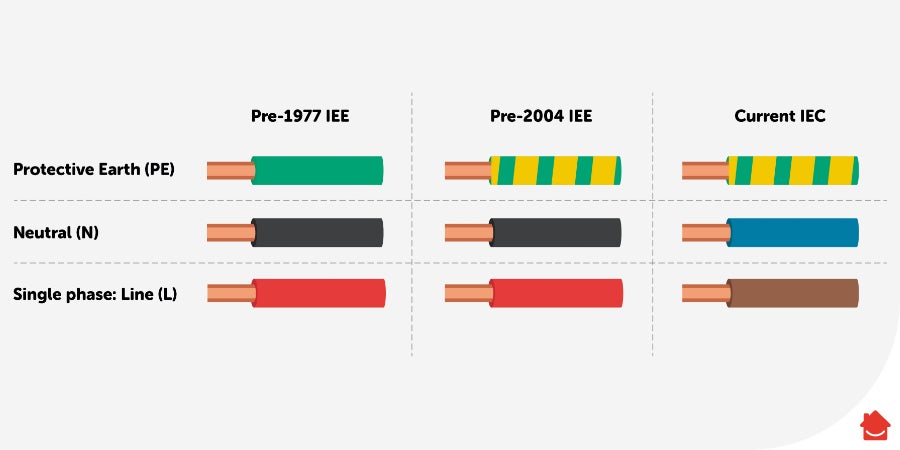 If your wiring was done after 2004, the wires you’ll find inside are:
If your wiring was done after 2004, the wires you’ll find inside are:
(L) Live = Brown
(N) Neutral = Blue
(E) Earth = Green and Yellow
This is also the same colour coding that has been used for UK appliance cords for many years.
A scorched socket is often caused by overloading or a loose connection in a plug. Don’t plug any appliances back in without solving this problem first or it will happen again.
Never attempt to do work on your electrics unless you know for sure that the circuit is electrically dead—legally only qualified and capable individuals should carry out this type of work.
Before undertaking work please review the safety first guidance at the top of this article.
Once you have confirmed the circuit is dead, unscrew the socket faceplate and gently pull the faceplate forward. You’ll need enough slack in the wires behind to be able to completely flip the socket down so that the back surface is accessible.
If you don’t feel comfortable doing this, stop here, screw everything back properly and get a professional to do the job. If all is well, move on to the next step and keep the screws in case the new ones don’t fit.
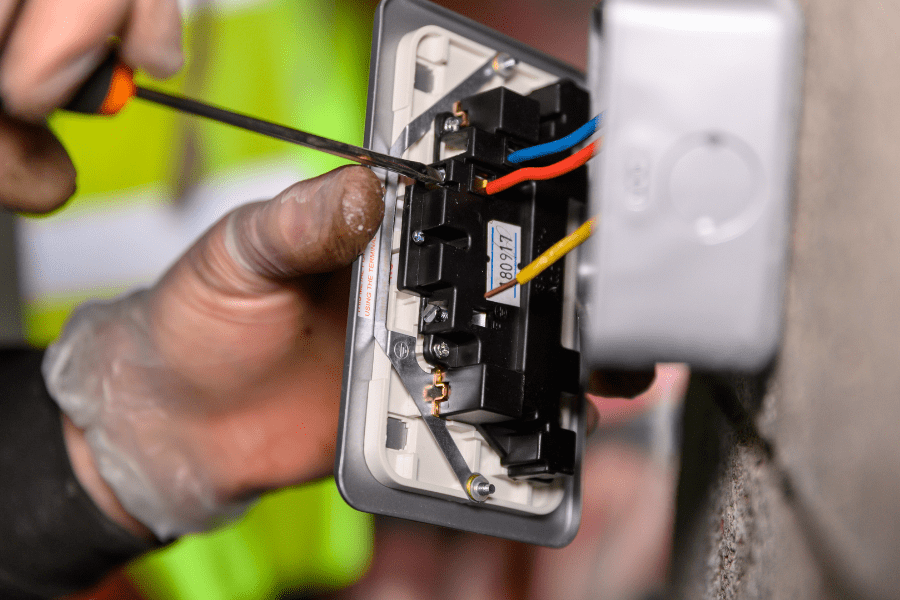
If the insulation has been heat damaged, and you have enough cable, cut back the cores and strip the ends, leaving 5 mm of copper on each wire exposed.
You’ll need to cover the earth core wiring with an extra length of green and yellow wire sleeving if it’s exposed.
The metal back boxes must be earthed, so run a short length of earth cable between the earth terminals of the back box and the faceplate.
Be careful – if you tighten too much, you can shear through your copper wire.
Being careful not to trap any of the wires between the socket and the socket box, fit the new faceplate. If the new screws don’t fit the old box, re-use the original screws you kept to one side. Be careful not to over tighten your screws – you don’t want to crack your new socket’s casing.
Undertake suitable and appropriate testing of the new socket to ensure that a sound pathway to earth is available.
If you are replacing a new plug socket there are big differences in how you do this according to the wall surface.
Start by checking if you’re fitting into a solid wall or a stud wall, put on some protective goggles and follow the appropriate steps.
Before undertaking work please review the safety notice at the top of this article.
To flush mount a socket in a solid wall, you’ll need to cut a recess into the plaster and the masonry behind it.
Once you have your tools ready to go, simply follow these steps:
If the coast is clear, isolate the relevant circuit at your fuse box and safe isolation to make sure the circuit is dead (triple-check this).
Get your new socket’s mounting box, a pencil and your spirit level ready. Then hold up your mounting box in the position you want it and use a spirit level to get it level. Now you can draw around the box on the wall.
Now take your hammer action drill, fitted with a masonry drill bit and make a number of holes within the outline to a slightly greater depth than the depth of the mounting box. Some drills have a depth stop that you can set to the required depth. If you don’t have this you can wrap some masking tape around the bit to show you where to stop.
Next, take your bolster and club hammer and start chipping out the plaster and masonry, cutting down to the depth of the holes you drilled.
Use your dustpan and brush to clear away all the plaster debris. Now check how the box fits.
While holding the box in place, mark the position with your pencil. Now drill the holes and put in the wall plugs.
Carefully remove the knock-out access holes and insert the proactive grommet and insert the cable through the access hole.
Take suitable and appreciate testing to ensure electrical safety.
The easiest way to flush-mount a socket into a stud wall is with a cavity fixing box. It sits against the face of the wall and has either rotating or spring-loaded lugs that press against the back of the plasterboard to help you position the socket more easily.
Before undertaking work please review the safety notice at the top of this article.
Now that you have your tools, it’s time to get started.
If you don’t have a stud detector, tap the wall gently with a hammer handle and listen for the hollow sound to change when you tap over the framework.
Now check the area is free of hidden pipes or cables with your pipe and cable detector.
If the coast is clear, isolate the relevant circuit at your fuse box and safe isolation to make sure the circuit is dead (triple-check this).
Hold the cavity fixing box in the place you want it, using a spirit level to keep it level, then draw around the box in pencil.
Now get your screwdriver and push and twist it through the wall inside the pencil outline at diagonally opposite corners, to provide a guide for your pad saw or plasterboard saw blade.
If the box fits snugly in the hole, push it in, feeding the cable through the opening.
Take suitable and appreciate testing to ensure electrical safety.
And that’s it! You should now have the electrical socket you chose in place.
We cannot stress enough that if you aren’t comfortable tackling a technical DIY job like this, leave it to a professional electrician.
If you’re renovating your house and want a more refined look in your home, you’d be surprised how different your home looks when you’ve changed up the plug sockets. It’s a simple job to DIY because it’s using an existing fitting, so it’s within the powers of a beginner DIYer, as long as you’re super safety-conscious.
A spur socket is an extra socket that has been added to an electric circuit. It usually has three cables – a ring main in, ring main out, and the spur going out.
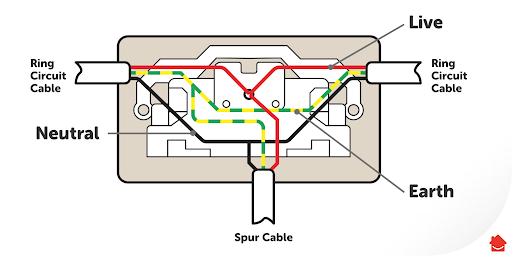
No. If you’re just changing the style of your electrical socket or switching to a USB socket, it’s a simple enough task for a confident, beginner DIYer to do.
Before undertaking work please review the safety notice at the top of this article.
It’s easy to replace an electric socket if you’re replacing like for like e.g. simply changing the style of the sockets. If you need to move the socket e.g. from surface mount to recess, then it’s a much more involved task and you will need to cut into the wall.
Our help & advice articles cover Plumbing, Home heating, Electrical, Energy-saving and Home maintenance.